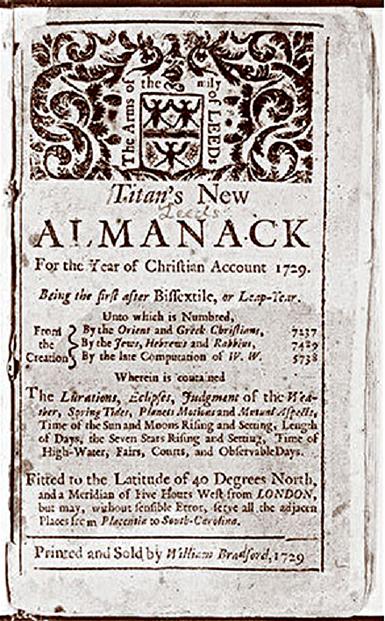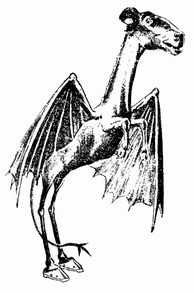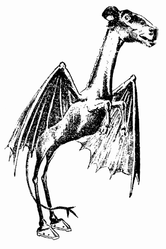It's not even certain that Swedish missionaries and other settlers - who were the second people to enter the Pine Barrens - really did name the area Drake Kill (River/Stream of the Dragon). Not least because the draconian etymology of 'drake' is Dutch ('draak'). The Swedes call it a 'dragon', just like the English.
Moreover, the word Poquessing seems to have related only to a stream, that later formed the state boundary between New Jersey and Philadelphia. It was variously documented as Pouquessinge, Poetquessingh or Ponquessiuge, depending upon whether a Swede, Dutch, French or English listener was trying to transcribe the syllables that they heard spoken by the Lenni-Lenape.
As none of them knew that they were supposed to be recording the earliest written evidence of a legendary creature, they didn't mention any dragons at all. Most of them interpreted Poquessing as something to do with pike.
Big fish in the river, not flying goat horses in the trees. It was an easy mistake to make.
Though in all fairness, Swedish Lutheran clergyman Johannes Campanius - who learned the Lenni-Lenape language in 1643 for Christian evangelical purposes - DID call the waterway Drake Kylen, which is a bit like Drake Kill if you say it fast enough. Only he thought he was talking about ducks at the time, not dragons.
Mind you, Campanius (and later his son Thomas) was also quite concerned with eradicating all of the French names for New Jersey places. The Florentine pirate explorer Giovanni da Verrazzano had left them littered all over the map in 1524. Sailing in the service of the French government, he'd charted the waterways - including Poquessing - with his Gallic crew.
It wasn't good for Sweden to have the French citing this as a prior claim to the land. Hence Drake Kylen came from Campanius needing something other than La Rivière de Kakimon (or Kakamon - pike in Lenni-Lenape) to call the river.
The Swedish missionary's thinking was either:
- 'This cold river (kylen = 'blast of cold air', 'chilly', 'fridge') has ducks on it. Let's call it Drake Kylen.' Or,
- 'Oh no! There's a dragon! Let's find out what the Dutch call dragons, then misspell it Drake and stick a Kylen on the end. The latter being in the sure knowledge that those who came after me will know that I patently couldn't spell and I meant Kill. Then, in 1876, that nice English-speaking Mr Levine will alter it for me, thus clarifying I meant 'River of the Dragons'. Because Kill is 'river' in Dutch. And it won't be a dragon if the second word isn't also in Dutch, it'd just be a male duck.'
It's a mystery that may never be solved. Though we do know that it took until the 20th century before Drake Kill began being referred to in guide-books, then web-pages, as being Swedish for 'Dragon River'. Much to the confusion of Swedes everywhere.
Moreover, that translation was then attached to Poquessing itself. Suddenly the original river name was stretched to include the entire Pine Barrens and said to mean 'Place of the Dragons'. Thus popularly serving as evidence for pre-Colonial Era sightings of the Jersey Devil.
Incidentally, it's spelt Poetquessnink in modern Lenni-Lenape. It means 'place where the mice live'.






















































 St Tydecho's Churches in West Waleson 09/03/2014
St Tydecho's Churches in West Waleson 09/03/2014
 Goodies for an Outlander Premiere Partyon 03/06/2015
Goodies for an Outlander Premiere Partyon 03/06/2015
 Holocaust Memorial Day Interview with Rainer Höss, Grandson of Rudolf Architect of Auschwitzon 01/24/2015
Holocaust Memorial Day Interview with Rainer Höss, Grandson of Rudolf Architect of Auschwitzon 01/24/2015
 Romantic Valentine Gifts for an Outlander Fanon 01/16/2015
Romantic Valentine Gifts for an Outlander Fanon 01/16/2015



Comments
He's in your 'hood? I'd love to hear more about the area. Jersey Devil aside, the Pine Barrens sound wonderful.
Wow what a thorough page about our little devil...lol...I've been to the pine barrens many times and have yet to run across him :-)
Ah!
And I am so on board with that time machine idea!
The October issue is sent out in September.There are some good articles in it.
If I ever get a time machine, you and I can go roaming about in it. We both have lots to look at.
From the future? If you have a time machine, you really need to share. I am a historian! I need one!
Yes. See Country Smallholding, Oct 2014, for an article and a report on earth sheltered dwellings.
I'd love to have lived in Skara Brae too. Any of those homes which end up underground have my vote. Have you seen those hobbit type homes that people have made for themselves?
Maybe you would like a hobbit hole! But life in caves was natural to humans, and in the past people dug their houses into earthen pits. That was common in Bronze Age Britain. Skara Brae in Orkney was a beautifully earth sheltered dwelling where the stone houses seem to have been covered by earth.
You know, I never quite envisaged what a fox's earth would look like. I kind of vaguely imagined a big hole. That sounds amazing. I'd like to live in something like that!
No. There is no room in the containers. A fox's earth is a large network of tunnels and cavities underground; and it can be a few feet deep.